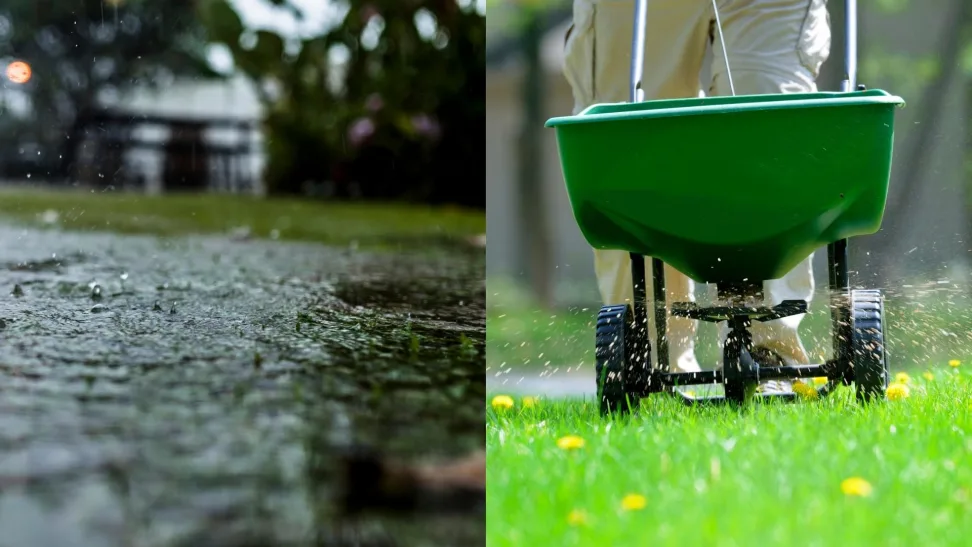When to Mow Before Fertilizing Your Lawn: Timing Your Lawn Service
Understanding the optimal time to mow before fertilizing is crucial in lawn care. Many homeowners have a common question: Should the lawn be mowed first or is it better to fertilize before those blades ever touch the grass? The answer lies in the health and condition of your lawn, as well as the grass type you have. When deciding when to mow, consider that the goal of fertilization is to deliver nutrients directly to the roots of your grass. Mowing, therefore, should ideally be done prior to fertilizing to prepare the lawn for the best possible nutrient uptake.
Mowing your lawn before fertilizing serves multiple purposes. It removes the excess grass length, which can otherwise block compost particles from reaching the soil. A freshly mowed lawn ensures that the spreader can distribute the compost evenly, allowing optimal soil contact.
As a rule of thumb, wait for 24-48 hours after trimming before you start fertilizing. This brief wait period allows the grass to recover from the stress of being cut, ensuring it’s in the best condition to absorb nutrients.
In terms of lawn service, professional teams like Turf Medic often recommend trimming your lawn to a third of its height. This is seen as the sweet spot where the grass is not too short to risk ‘scalping’ the lawn and not too long to hinder the effectiveness of the fertilization process. Recognizing the requirements of your specific grass type is also key.
Factors to Consider Before Fertilizing
1. Soil Test Results: Before applying compost, it’s crucial to perform a soil test to determine the nutrient levels present in your soil. This can help decide the type and amount of it required to address deficiencies.
2. Plant Requirements: Different plants have unique nutritional needs. Consider the specific requirements of the crops or plants you are growing, and choose a compost that matches their particular growth stages and nutrient demands.
3. Fertilizer Composition: Evaluate the N-P-K ratio (nitrogen, phosphorus, potassium), secondary nutrients, and micronutrients in the fertilizer to ensure it is appropriate for your soil’s needs and the plants you’re growing.


4. Application Timing: The timing of application can significantly affect plant growth and yield. Factor in the plant’s growth cycle and apply fertilizers at times when plants can most use the added nutrients.
5. Environmental Impact: Consider the potential environmental effects of compost use, such as runoff leading to water pollution. Opt for environmentally safe application methods and rates that minimize negative impacts on the surrounding ecosystem.
Grass Mowing Guidance: Mow or Fertilize First?
Deciphering whether to mow or fertilize first is a decision critical to the health and beauty of your lawn. Grass, like any other plant, requires a precise balance of nutrients and care to thrive. Mowing can stress your lawn, but if done correctly, it prepares the grass for better nutrient absorption. In the realm of lawn care, the sequence of trimming and fertilizing plays a significant role in achieving a lush, vibrant lawn.
As seasoned experts at Turf Medic, we understand the intricacies of lawn maintenance. It’s often advised to mow before fertilizing. Mowing the lawn before fertilization aids in its even distribution and enables the nutrients to penetrate the soil more efficiently, reaching the grassroots where they’re most needed.
Yet, one should also consider the condition of the grass when deciding whether to mow or fertilize first. If your lawn is stressed from drought, pests, or disease, it’s best to address these issues before any trimming or fertilization occurs. Once your lawn is deemed healthy, proceed with trimming, then follow up with the application of the appropriate compost. It’s essential to ensure the grass isn’t too short, as extremely low trimming, known as “scalping,” can damage the lawn making it susceptible to weeds and diseases.
Maximizing Lawn Health: Before You Fertilize, Understand the Best Day to Mow
When it comes to maximizing lawn health, striking the right balance between various lawn care tasks is essential. Before you reach for the fertilizer, it’s important to determine the best day to mow that will complement the fertilization process. In the world of turf management, timing is everything. Many homeowners ponder whether to fertilize before or after trimming, but the answer isn’t always straightforward.
Considering the best day to mow is more than just looking at your calendar; it involves understanding your lawn’s unique characteristics and the current conditions. Lawn care experts agree that generally, trimming should precede fertilizing by a few days. This approach allows the grass blades to heal from any trimming-induced stress and presents a more uniform and receptive surface for fertilizers to work effectively.
Additionally, mown grass helps distribute the compost more evenly and prevents particle clumping. If you’re seeking to optimize nutrient uptake and desire even growth post-application, considering the day before you take action is key.
Pros of Moving Before Fertilizing
- Optimal Nutrient Absorption: Moving before fertilizing can help ensure that the soil is properly prepped, allowing for better nutrient absorption.
- Reduced Waste: By trimming before applying fertilizer, you can help prevent the leaching of nutrients that can occur when compost falls on long grass blades and is washed away by rain or irrigation systems.
- Even Distribution: Short grass allows for a more even distribution of fertilizer, reducing the risk of patches of over- or under-fertilized areas, resulting in an uneven lawn appearance.


- Boosted Efficiency: Mowing can help remove debris and thatch from the lawn, which can obstruct the distribution of fertilizer, thus trimming first can make the fertilization process more efficient.
- Prepared Growth Environment: Trimming your lawn before fertilizing can encourage the grass to grow denser and healthier, providing a robust environment for the new growth that is supported by fertilization.
How Often Can You Fertilize Your Lawn?
Understanding how often you can fertilize your lawn is pivotal to ensuring its health and vigor. Lawn care is an intricate balance between the right practices and products, and timely fertilization is one part of this balance. The guiding principle of lawn fertilization is not just about application; it’s also deeply entwined with the lawn’s growth cycles and nutritional demands. As a general approach, adding fertilizer to your lawn should align with key growth phases, typically requiring the first fertilizer application once in the early spring to kick-start growth after the dormant winter period.
But how often can you add this essential nutrient boost to your turf? The answer depends on your lawn’s specific requirements and the type of fertilizer being used. A good rule of thumb is to plan to fertilize your lawn several times throughout the growing season.
Using a slow-release nitrogen-based product can reduce how often you need to fertilize, as it provides a steady nutrient supply over time. This could reduce the frequency to about every six weeks, ensuring a sustained lawn care regimen that boosts growth without overwhelming your grass with too much nitrogen.
It’s important to remember that fertilization is only one aspect of lawn care. Other factors, such as the type of grass, soil conditions, and local climate, must also be considered. Adding fertilizer responsibly is also essential, as excessive use can lead to nutrient runoff and environmental harm.
Choosing the Right Fertilizer for Your Lawn: Share the Best Service Practices
As lawn care experts, we at Turf Medic understand the importance of selecting the right fertilizer for the health and vitality of your lawn. It’s critical to share service practices that help achieve the lush, green grass every homeowner desires. The right compost is a cornerstone of good lawn care, and choosing it isn’t just about grabbing any bag off the shelf. You must consider the specific needs of your soil and grass type; these factors determine the appropriate balance of nitrogen, phosphorous, potassium, and other micronutrients your lawn requires.
Fertilizing is an essential service that provides your lawn with the necessary nutrients for growth and resilience. It can yield remarkable results when done correctly, but timing is everything in fertilizer application. That’s why we provide services that test your soil and believe it’s best to fertilize your lawn after trimming. Using a spreader, we ensure an even distribution of fertilizer. Our experts advocate for service practices that prioritize the best time to apply fertilizer, usually when the lawn is freshly cut and the soil is prepped to receive nutrients.
Service excellence in lawn care encompasses a comprehensive approach that involves more than just dispensing products. At Turf Medic, we focus on enriching the soil, so the grass can tap into a well of nutrients. We don’t just choose a fertilizer for our clients; we tailor our services to each lawn’s unique profile. Our aim is to consistently share the best service practices, ensuring your lawn benefits from the highest standards in lawn care service.
Turf Medic Can Take Care of Your Lawn Needs
When it comes to lawn care, there’s no one-size-fits-all solution. Every lawn is different, and each requires a personalized approach to achieve its full potential. That’s where Turf Medic comes in. Our team of experts has years of experience in providing customized solutions for all types of lawns.
Contact our team today, and let us take care of your lawn’s needs!

Recent Comments